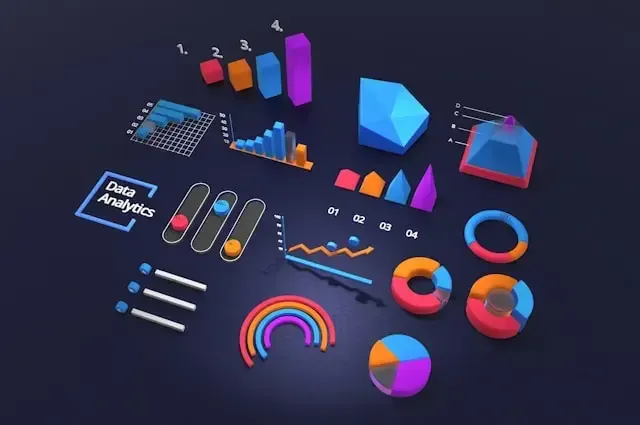In this article, we’ll dive into robotics, explore how robots work, and see how technology shapes the future with these amazing machines.
Robotics is a fascinating field that blends technology with innovation. Robots are changing how we live, work, and play. They can help us with everyday tasks, solve complex problems, and even explore other planets. In this article, we’ll dive into robotics, explore how robots work, and see how technology shapes the future with these amazing machines.
What Are Robots?
Robots are machines designed to perform tasks. They can range from simple devices that do one job, like a vacuum cleaner, to complex machines that can think and make decisions, like a robot used in surgery. Robots can be programmed to follow instructions and work independently or with human help.
How Robots Work
Robots are made up of several important parts that help them do their jobs. Here’s what’s inside:
- Sensors:
These are like the robot’s eyes and ears. Sensors help the robot see, hear, and feel things around it. For example, a robot vacuum uses sensors to find dirt and avoid bumping into furniture.
- Actuators:
Think of actuators as the robot’s muscles. They help the robot move parts like arms, legs, or wheels. When the robot needs to pick up something or move, actuators make it happen.
- Control System:
This is the robot’s brain. It takes the information from the sensors and tells the actuators what to do. The control system uses computer programs to decide what actions the robot should take.
How Do Robots Move
Robots move using different types of actuators:
- Motors:
Motors help robots move their arms, legs, or wheels.
- Servos:
Servos are special motors that can control the position of a robot’s parts very precisely.
How Do Robots Know What to Do?
Ever wonder how robots seem to know exactly what to do? It’s pretty cool! Robots follow special instructions to perform tasks. Let’s dive into how they figure out what to do.
- The Robot’s Brain
Robots have a “brain” called a control system. This brain is a computer that takes information from the robot’s sensors and tells its parts what to do. Think of it like a recipe book for the robot. Just like a recipe tells you how to make a cake, the control system tells the robot how to complete its tasks.
- Following Instructions
Robots follow a set of instructions called “code” or “software.” This code is written by people and tells the robot what steps to take. For example, if a robot needs to pick up a box, the code will include steps like finding the box, moving the arm to grab it, and lifting it up.
- Using Sensors
Robots have sensors that act like their senses. These sensors help the robot see, hear, or feel things. For instance, a robot vacuum uses sensors to detect dirt on the floor and avoid bumping into furniture. The control system reads this information and makes decisions based on it.
- Making Decisions
When a robot gets information from its sensors, the control system decides what to do next. For example, if a robot sees an obstacle in its path, it will decide to go around it. This decision-making process is based on the instructions it has been given.
Communication with Robots
- How Robots communicate with humans.
Some robots can also talk to humans or other robots. Robots use various tools to talk to us. Here are some common ways:
- Screens:
Some robots have screens that show messages or information. For example, a robot might display “I’m cleaning now” on its screen.
- Speakers:
Robots with speakers can talk to you. They might say things like “Hello!” or “I’m done with my task.”
- Lights:
Robots sometimes use lights to communicate. They might flash different colors to show different actions, like green for “all done” and red for “something’s wrong.”
- How Robots Talk to Each Other?
Robots can also talk to other robots, especially in big systems. They use:
- Wireless Signals:
Like Wi-Fi, robots can send messages to each other using wireless signals. This helps them coordinate and work together.
- Sensors:
Robots use sensors to “see” what other robots are doing. They can adjust their actions based on what they sense from their robot friends.
- Why Communication is Important
- Communication helps robots:
- Work Efficiently:
Robots can share information to get their tasks done faster and more accurately.
- Avoid Problems:
Talking to each other helps robots avoid collisions and mix-ups.
- Help Us Better:
When robots communicate well, they can assist us more effectively and let us know what they’re up to.
Types of Robots
- Industrial Robots
These are used in factories to build things like cars or electronics. They can work fast and accurately.
- Service Robots
These robots help people with everyday tasks. For example, a robot might clean your house or deliver food.
- Medical Robots
These robots assist doctors in surgeries or help with patient care. They can perform precise tasks that are difficult for humans.
- Exploration Robots
These robots explore places that are hard for humans to reach, like the surface of Mars or the deep ocean.
How Technology Shapes Robotics
Technology is constantly improving, and it has a big impact on how robots are built and used. These advancements make robots smarter, more capable, and more versatile. Let’s look at some of the exciting ways technology is changing the world of robotics:
- Better Sensors
Sensors are like the robot’s eyes and ears. New and improved sensors help robots understand their surroundings better. For example:
- Enhanced Vision Sensors:
Modern robots use advanced cameras and sensors to see objects more clearly. This helps them recognize different items, navigate around obstacles, and even identify faces.
- Improved Touch Sensors:
These sensors allow robots to feel objects with greater sensitivity. They can detect how hard or soft an object is, which is useful for tasks like picking up fragile items without damaging them.
- Advanced Environmental Sensors:
These sensors help robots detect things like temperature, humidity, and gas levels. This is important for robots working in environments where these factors need to be monitored closely.
- Advanced AI (Artificial Intelligence)
AI is like the brain of the robot, helping it learn and make decisions. Here’s how AI is making a difference:
- Machine Learning:
AI allows robots to learn from their experiences. For instance, a robot can improve its performance in tasks like sorting items or navigating a room by learning from past mistakes and successes.
- Decision-Making:
With AI, robots can make more complex decisions. For example, a robot might decide the best way to perform a task based on its observations and the goals it has been given.
- Adaptability:
AI helps robots adapt to new situations. If a robot encounters a new type of obstacle, its AI system can help it figure out how to handle it effectively.
- Improved Materials
New materials are making robots lighter, stronger, and more flexible. Here’s how:
- Lightweight Materials:
Advances in materials science have led to the creation of lightweight yet strong materials. This makes robots easier to move and operate, which is important for tasks that require agility and speed.
- Durable Materials:
New materials are also more durable, allowing robots to withstand harsh conditions. This is particularly useful for robots used in environments like factories or outdoor settings.
- Flexible Materials:
Some new materials can bend and stretch without breaking. This flexibility allows robots to perform a wider range of movements and tasks.
- Robotics Software
Software is crucial for controlling and programming robots. Here’s how improvements in software are helping robots:
- Efficient Algorithms:
Better software algorithms help robots perform tasks more efficiently. For example, improved algorithms can make a robot vacuum cleaner work faster and clean more thoroughly.
- Expanded Capabilities:
New software allows robots to perform a wider variety of tasks. With updated software, a robot can switch between different tasks, such as cooking and cleaning, without needing a complete redesign.
- User-Friendly Interfaces:
Modern software includes user-friendly interfaces that make it easier for people to program and control robots. This means more people can use robots for various applications without needing advanced technical skills.
The Future of Robotics
Robotics is evolving rapidly. Here’s what we might see in the future:
- More Personal Robots:
We might have robots that can help with household chores, like cooking or gardening.
- Robots in Education:
Robots could become common in schools, helping students learn and explore new subjects.
- Advanced Medical Robots:
Future robots might be able to perform complex surgeries with even more precision.
- Robots in Space Exploration:
As we explore outer space, robots will play a key role in gathering information and conducting experiments.
How Robots Have Benefited People
Robots bring many benefits to our lives, making various tasks easier and more efficient. Here’s a closer look at how robots can help us:
- Increase Efficiency
Robots significantly boost productivity in various industries. They work faster and more accurately than humans, which is especially beneficial in factory settings. For example, robots can quickly assemble products on production lines with precision, ensuring consistent quality. They don’t get tired or need breaks, which helps maintain high performance throughout their work shifts.
- Perform Dangerous Jobs
Robots are invaluable for handling tasks that are too risky for humans. They are used to explore hazardous environments, such as deep underwater or in space, where human safety might be compromised. In emergencies, robots can enter dangerous areas to search for survivors or assess damage, protecting human rescuers from harm. They can also manage hazardous materials, reducing the risk to human health.
- Assist with Daily Life
In everyday life, robots provide convenience by helping with household tasks. Robotic vacuum cleaners and mops make cleaning easier by handling these chores with minimal effort. Advanced robots can assist in cooking by chopping vegetables or stirring dishes. Additionally, robots designed for companionship offer social interaction and support, which is particularly beneficial for elderly individuals or those with disabilities.
Challenges in Robotics
Despite their many advantages, robots also face some challenges. Here are a few of them:
- Cost
The development and maintenance of robots can be quite expensive. Creating robots requires advanced technology and skilled engineers, leading to high initial costs. Ongoing maintenance and repairs also contribute to the overall expense. The initial investment can be a barrier for some businesses or individuals considering the use of robots.
- Complexity
Building robots that can perform complex tasks and make intelligent decisions is challenging. Programming robots to handle diverse tasks and adapt to new situations involves sophisticated software and algorithms. Integrating various technologies, such as sensors and artificial intelligence, into a single robot adds to the complexity of the design and functionality.
- Ethical Issues
As robots become more advanced, several ethical concerns arise. Job displacement is a major issue, as robots can replace human workers in certain roles, potentially leading to unemployment and economic impacts. Privacy concerns also emerge with the use of robots for surveillance or data collection. Additionally, there are questions about how robots should make decisions, particularly in sensitive areas like healthcare and safety, raising important ethical considerations.
Conclusion
Robotics is a field full of exciting possibilities. As technology continues to advance, robots will play an even bigger role in our lives. From helping with everyday tasks to exploring the far reaches of space, robots are shaping the future in amazing ways. Whether you’re fascinated by the technology or curious about what’s next, the world of robotics offers endless opportunities for discovery and innovation.


























